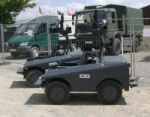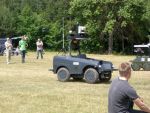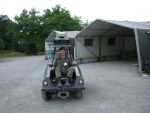Robotik: CANGURU — Diehl BGT Defence
 ELROB2008 was a great chance for the Diehl BGT Defence team to get into contact to MoD, military users and companies as well as to universities and institutes to learn the status of technological solutions and especially get aware of users needs. This gives them the possibility to align the development roadmap to be most efficient within the young team (started in the beginning of 2007 on the area of “autonomy”) concerning intelligent, mobile soldier assistance systems like the presented CANGURU (the vehicle internally/nationally also known as MUSTANG MK I). A task and user oriented implementation of scalable autonomous functions has been started and will be one focus for further research and development. Goals are force protection, securement, camp / convoy security, MULE with transport, convoying as well as local reconnaissance and “guard dog” functions.
ELROB2008 was a great chance for the Diehl BGT Defence team to get into contact to MoD, military users and companies as well as to universities and institutes to learn the status of technological solutions and especially get aware of users needs. This gives them the possibility to align the development roadmap to be most efficient within the young team (started in the beginning of 2007 on the area of “autonomy”) concerning intelligent, mobile soldier assistance systems like the presented CANGURU (the vehicle internally/nationally also known as MUSTANG MK I). A task and user oriented implementation of scalable autonomous functions has been started and will be one focus for further research and development. Goals are force protection, securement, camp / convoy security, MULE with transport, convoying as well as local reconnaissance and “guard dog” functions.
The Diehl team had the chance to measure and store a variety of data under real environment system operation during ELROB2008 to test and verify the systems performance and to adjust further developments precisely relying on the results which were achieved.
 The vehicle basic platform is based on a cost-effective commercial-off-the-shelf solution. Its weight is about 350 kg and the load capacity is 250 kg (please refer to specification data at the end of the article). It is fully digitized. The assistance system comprises a hybrid drivetrain for long range operation (200 km / 6–10hrs) capabilities as well as silent movement. Various changes and modifications have been done to first give the experimental demonstrator a military chassis and more robust functionalities with respect to operations in unstructured terrain and more environmental suitability while operating.
The vehicle basic platform is based on a cost-effective commercial-off-the-shelf solution. Its weight is about 350 kg and the load capacity is 250 kg (please refer to specification data at the end of the article). It is fully digitized. The assistance system comprises a hybrid drivetrain for long range operation (200 km / 6–10hrs) capabilities as well as silent movement. Various changes and modifications have been done to first give the experimental demonstrator a military chassis and more robust functionalities with respect to operations in unstructured terrain and more environmental suitability while operating.
The system core functions (drive-by-wire and remote control) are realized PC free comprising a microcontroller board computer. This leads to instant power on and a very robust, fail safe core operation. Additionally the system comprises two mini PC units to process navigation as well as vision sensing data in an effective way. One PC is processing laser rangefinder datastreams and ultrasonic sensors data as well as the system communication data (control station to robot and robot-to-robot), the other one is processing a groundsensor, the GPS/inertial data and the data from the CCD camera used for the “following function”. Herein, the operating system is Linux.
Currently, the vehicle is incorporating two autonomous modes which will be enhanced in succession. The first one is the autonomous following function (follow person, jeep, UGV etc.) and the second one is the autonomous surveillance / reconnaissance function based on waypoint planning and execution.
 After planning the tasks / mission with help of the graphical user interface of the mission planning tool, the system is able to follow the set of waypoints autonomously preventing collisions with negative and positive obstacles. In same cases, requesting the operator could happen if the local situation assessment is unclear. The waypoint-to-waypoint trajectory is always calculated as linear movement. Short trajectories will be able to be bypassed without receiving a GPS signal. The mode is day and night capable.
After planning the tasks / mission with help of the graphical user interface of the mission planning tool, the system is able to follow the set of waypoints autonomously preventing collisions with negative and positive obstacles. In same cases, requesting the operator could happen if the local situation assessment is unclear. The waypoint-to-waypoint trajectory is always calculated as linear movement. Short trajectories will be able to be bypassed without receiving a GPS signal. The mode is day and night capable.
While moving, the environment is perceived through laser range finders, vehicle platform cameras and a monocular vision system. A payload reconnaissance suite comprises an infrared camera (micro-bolometric) and a 360° CCD colour zoom camera.
As a status, a so called “hybrid usage” comprising 3 different modes of operation has been realized. Drive-by-wire function performed by the operator on-board, single-person remote controlled operation with a portable ground control station and the mission or task planned operation (use of a standard, ruggedized notebook) with the two autonomously running functions described above. The portable ground control station also delivers the operator vehicle status information (attitude, energy, drivetrain etc) to be aware of system operability.
The key characteristics of the system are the following.
| Height | ~2.20 m |
| Width | 1.11 m |
| Length | 2.15 m |
| Weight | 350 kg |
| Ground clearance | 0.2 m |
| Climbing performance | 45 % |
| Propulsion / drivetrain | Hybrid ~3 kW / 4‑wheel drive |
| Endurance | 6–10 h |
| Maximum speed | 20 km/h |
| Maximum range (w — w/o communication) | 2.5 — 200 km |
| Load capability | ~250 kg |
The team is led by Dirk Krogmann, Diehl BGT Defence GmbH & Co. KG, programme manager, with his office at Ueberlingen, Germany. The technical point of coordination is Thomas Kopfstedt, Diehl BGT Defence GmbH & Co. KG, Ueberlingen. The vehicle is realized under cooperation with the Fraunhofer Institute for Information and Data Processing, led by Andreas Wenzel, head of embedded systems at the institute subsidiary in Ilmenau, Germany. The development is supported by the German Federal Ministry of Defense, the Federal Office of Defense Technology and Procurement and the Technical Center 51, Koblenz.
Image source: Diehl BGT Defence GmbH & Co. KG

 von
von 